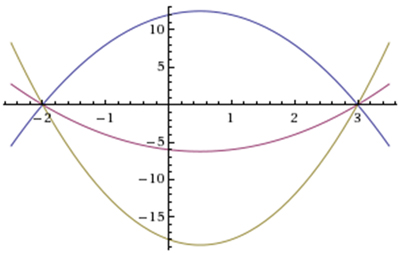
In this lesson you will learn how determine a quadratic function from its roots (real and complex). You can be told what the roots are, or you can find the roots from its graph.
In this section, let’s say you are given two roots to a function that is known to be quadratic.
How many possible quadratic functions exist that have these two roots? Click here to check your answer.
For example, if the roots are (-2,0) and (3,0), consider the following functions:

All of these quadratic functions have roots at (-2,0) and (3,0).
So, if (3,0) is a root, that means we know one factor of the quadratic equation. Name that factor. Click here to check your answer.
Now, if (-2,0) is a root also, what would the other factor be? Click here to check your answer.
So, if we know (x - 3) and (x + 2) are factors, then one possible solution is
y = (x - 3)(x + 2).
which can be multiplied and written as
y = x2 - x - 6.
If you are having difficulty with the above multiplication that generated the answer
y = x2 - x - 6, click the following link to connect to a website that can help you better understand the multiplication process. Multiplying Binomials
How can we create the other solutions if the function must remain quadratic? Click here to check your answer.